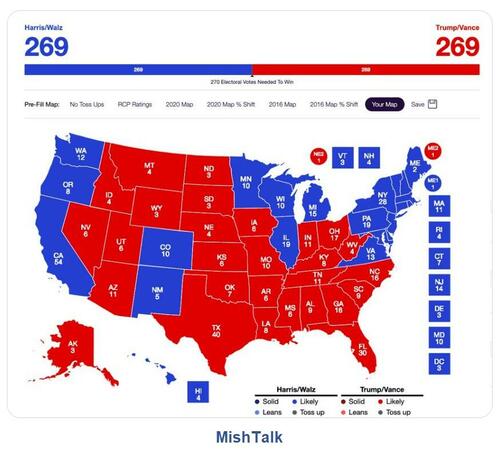
Authored by Mike Shedlock via MishTalk.com,
In case of a tie, the House of Representatives would decide. This favors Trump. But what are the odds? I make a guess...
The above map is not contrived or convoluted. It is the current state of affairs except for Nebraska and a small lead for Harris in Nevada, reversed in the above map. However….
Please note Republicans Push to Change Nebraska’s Electoral System
Nebraska Republicans are pushing for the state to change its electoral vote process to a winner-take-all system, which could give former President Donald Trump an extra electoral vote in this year’s close presidential race.
Nebraska’s all-Republican congressional delegation sent a letter to Nebraska Gov. Jim Pillen (R) and Speaker of the Legislature John Arch (R) asking them to pass and sign a bill that would make this change.
How does Nebraska’s electoral system work?
Currently, Nebraska is one of the only states in the country that doesn’t award all of its electoral votes to the presidential candidate who received the most votes statewide, which is a winner-take-all system. Instead, they split up their votes by congressional district.
The state has five electoral votes, a small fraction of the Electoral College — made up of 270 votes.
Nebraska has three congressional districts, and if a presidential candidate wins a district, they get a single electoral vote. If they win all three districts, they get three electoral votes. The state’s two remaining electoral votes go to the person who received the most votes statewide. This system has led to Nebraska splitting its Electoral College votes in the past.
In 2020, President Joe Biden lost to Trump in Nebraska statewide and in the mostly Republican districts, but he defeated him in the state’s 2nd congressional district, which includes Omaha — the state’s largest city. So, Trump garnered four electoral votes and Biden netted one. [Mish Comment: Polls show Harris is ahead in Omaha. Biden carried the district by 7 points.]
“As Governor of Nebraska, I will never waver in my commitment to do what is right for our state,” Pillen said. “As I have consistently made clear, I strongly support statewide unity and joining 48 other states by awarding all five of our electoral college votes to the presidential candidate who wins the majority of Nebraskans’ votes.”
However, he said he would only do this if he knew that 33 senators would vote for it. Nebraska has a unicameral legislature — meaning they only have one chamber in their legislature instead of two. The legislature is made up of 49 senators, so Pillen is asking for over two-thirds of the members to clearly and publicly express support for this.
Around 30 to 31 votes have been confirmed, the legislators said.
Time Expires in Maine
Maine, which operates on the same system, have threatened to do the same.
However, time has expired for Maine to make the change.
If Nebraska acts, Trump wins on 269 but Harris would need 270.
Advantage Trump
Correct. Trump would win.
— Mike "Mish" Shedlock (@MishGEA) September 20, 2024
Breaking an Electoral College Tie
In the House, each state delegation (not representative) would get one vote, with the presidency going to whoever wins a majority of state delegations.
Republicans currently control 26 of the 50 House delegations.
Regardless of who controls the House next year, Republicans are a strong favorite to remain in control of 26 House delegations.
This Has Happened Before
The Center for Politics discusses Breaking an Electoral College Tie
The presidential election of 1824 was the first one in which there is a tabulation of the actual popular vote for president, albeit not from every state. A majority of states in the Union at the time had adopted a popular vote for presidential electors; previously, presidential electors had generally been chosen by state legislatures. Thus, one can describe 2024 as representing the 200th anniversary of a popular vote for president, even if the totals represented only 18 of the 24 states voting at the time. (This history is from What Hath God Wrought: The Transformation of America, 1815-1848 by Daniel Walker Howe).
The 4-way presidential race failed to produce a majority winner in the Electoral College: Andrew Jackson finished first, with 41% of the popular vote and 38% of the electoral votes, short of the majority required for election. The election went to the House of Representatives, which brings us to the second bicentennial anniversary in 2024: 1824 was the most recent election in which the House decided the presidential winner. The 12th Amendment stipulates that in the event no one wins a majority of the Electoral College votes, the House chooses among the top 3 finishers in the Electoral College, with each state’s delegation getting a single vote. The House ended up backing the second-place finisher, John Quincy Adams. Jackson would get his revenge in a landslide victory 4 years later.
What Are the Odds?
Nate Silver and others have concocted bizarre scenarios to arrive at 269-269 math. The above map is not bizarre. It is currently one of the most likely scenarios.
Most likely scenario does not mean probable. There are thousands of scenarios, most of which are near-zero probability outcomes (for example Trump or Harris winning every state).
Nate Silver has Harris’ odds of winning Pennsylvania at 53.7%, Michigan at 61.8%, Wisconsin at 55.4%, and Trump winning Nevada at 47.4%.
If we assume every other state is as projected, the odds of 269-269 tie are 0.537 * 0.618 * 0.554 * 0.474 = 0.0871.
That would be an 8.7 percent chance. But It is not quite that simple because the other states are not guaranteed, reducing the odds.
Keep the above assumptions but factor in Arizona with Trump’s odds of winning at 64.5 percent and the tie odds drop to 5.7 percent. Also factor in Georgia the odds drop to 3.51 percent. And finally, factor in North Carolina and the odds drop further to about 2.3 percent.
But a correlation factor increases the odds depending on what assumptions we make. For example, if we assume Harris wins Wisconsin, her odds of winning Michigan and Pennsylvania rise because the states are similar in voting patterns.
Nate Silver has the deadlock odds at 0.3 percent.
Look for Silver’s odds of a tie to jump 8-fold or more. My crude calculation suggests the odds are between 2 and 3 percent but this can easily rise (or fall) over time.
Authored by Mike Shedlock via MishTalk.com,
In case of a tie, the House of Representatives would decide. This favors Trump. But what are the odds? I make a guess…
The above map is not contrived or convoluted. It is the current state of affairs except for Nebraska and a small lead for Harris in Nevada, reversed in the above map. However….
Please note Republicans Push to Change Nebraska’s Electoral System
Nebraska Republicans are pushing for the state to change its electoral vote process to a winner-take-all system, which could give former President Donald Trump an extra electoral vote in this year’s close presidential race.
Nebraska’s all-Republican congressional delegation sent a letter to Nebraska Gov. Jim Pillen (R) and Speaker of the Legislature John Arch (R) asking them to pass and sign a bill that would make this change.
How does Nebraska’s electoral system work?
Currently, Nebraska is one of the only states in the country that doesn’t award all of its electoral votes to the presidential candidate who received the most votes statewide, which is a winner-take-all system. Instead, they split up their votes by congressional district.
The state has five electoral votes, a small fraction of the Electoral College — made up of 270 votes.
Nebraska has three congressional districts, and if a presidential candidate wins a district, they get a single electoral vote. If they win all three districts, they get three electoral votes. The state’s two remaining electoral votes go to the person who received the most votes statewide. This system has led to Nebraska splitting its Electoral College votes in the past.
In 2020, President Joe Biden lost to Trump in Nebraska statewide and in the mostly Republican districts, but he defeated him in the state’s 2nd congressional district, which includes Omaha — the state’s largest city. So, Trump garnered four electoral votes and Biden netted one. [Mish Comment: Polls show Harris is ahead in Omaha. Biden carried the district by 7 points.]
“As Governor of Nebraska, I will never waver in my commitment to do what is right for our state,” Pillen said. “As I have consistently made clear, I strongly support statewide unity and joining 48 other states by awarding all five of our electoral college votes to the presidential candidate who wins the majority of Nebraskans’ votes.”
However, he said he would only do this if he knew that 33 senators would vote for it. Nebraska has a unicameral legislature — meaning they only have one chamber in their legislature instead of two. The legislature is made up of 49 senators, so Pillen is asking for over two-thirds of the members to clearly and publicly express support for this.
Around 30 to 31 votes have been confirmed, the legislators said.
Time Expires in Maine
Maine, which operates on the same system, have threatened to do the same.
However, time has expired for Maine to make the change.
If Nebraska acts, Trump wins on 269 but Harris would need 270.
Advantage Trump
Correct. Trump would win.
— Mike “Mish” Shedlock (@MishGEA) September 20, 2024
Breaking an Electoral College Tie
In the House, each state delegation (not representative) would get one vote, with the presidency going to whoever wins a majority of state delegations.
Republicans currently control 26 of the 50 House delegations.
Regardless of who controls the House next year, Republicans are a strong favorite to remain in control of 26 House delegations.
This Has Happened Before
The Center for Politics discusses Breaking an Electoral College Tie
The presidential election of 1824 was the first one in which there is a tabulation of the actual popular vote for president, albeit not from every state. A majority of states in the Union at the time had adopted a popular vote for presidential electors; previously, presidential electors had generally been chosen by state legislatures. Thus, one can describe 2024 as representing the 200th anniversary of a popular vote for president, even if the totals represented only 18 of the 24 states voting at the time. (This history is from What Hath God Wrought: The Transformation of America, 1815-1848 by Daniel Walker Howe).
The 4-way presidential race failed to produce a majority winner in the Electoral College: Andrew Jackson finished first, with 41% of the popular vote and 38% of the electoral votes, short of the majority required for election. The election went to the House of Representatives, which brings us to the second bicentennial anniversary in 2024: 1824 was the most recent election in which the House decided the presidential winner. The 12th Amendment stipulates that in the event no one wins a majority of the Electoral College votes, the House chooses among the top 3 finishers in the Electoral College, with each state’s delegation getting a single vote. The House ended up backing the second-place finisher, John Quincy Adams. Jackson would get his revenge in a landslide victory 4 years later.
What Are the Odds?
Nate Silver and others have concocted bizarre scenarios to arrive at 269-269 math. The above map is not bizarre. It is currently one of the most likely scenarios.
Most likely scenario does not mean probable. There are thousands of scenarios, most of which are near-zero probability outcomes (for example Trump or Harris winning every state).
Nate Silver has Harris’ odds of winning Pennsylvania at 53.7%, Michigan at 61.8%, Wisconsin at 55.4%, and Trump winning Nevada at 47.4%.
If we assume every other state is as projected, the odds of 269-269 tie are 0.537 * 0.618 * 0.554 * 0.474 = 0.0871.
That would be an 8.7 percent chance. But It is not quite that simple because the other states are not guaranteed, reducing the odds.
Keep the above assumptions but factor in Arizona with Trump’s odds of winning at 64.5 percent and the tie odds drop to 5.7 percent. Also factor in Georgia the odds drop to 3.51 percent. And finally, factor in North Carolina and the odds drop further to about 2.3 percent.
But a correlation factor increases the odds depending on what assumptions we make. For example, if we assume Harris wins Wisconsin, her odds of winning Michigan and Pennsylvania rise because the states are similar in voting patterns.
Nate Silver has the deadlock odds at 0.3 percent.
Look for Silver’s odds of a tie to jump 8-fold or more. My crude calculation suggests the odds are between 2 and 3 percent but this can easily rise (or fall) over time.
Loading…





